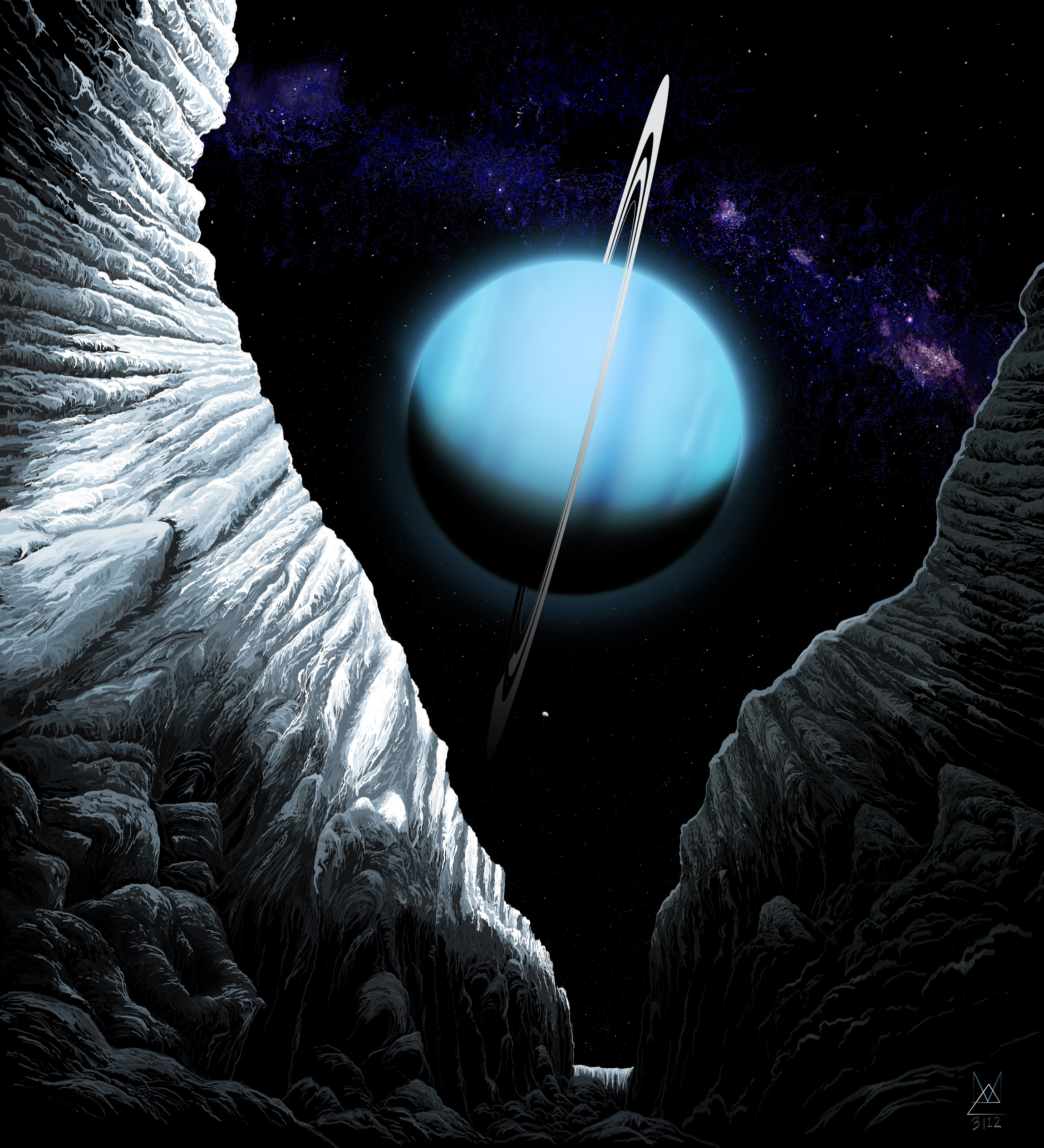ShopDreamUp AI ArtDreamUp
Deviation Actions
Description
The distant ice giant, Uranus hangs above a deep, icy chasm on the surface of its innermost major satellite, Miranda. Though only a mere 480-km in diameter, it hosts an exotic assortment of geologic features, including massive cliffs, deep fault, canyons, plains, craters, mountain ranges and ridges. This bizarre melange of geological features may have come about during a period of intense internal heating caused by tidal interactions with Uranus and its neighbouring moons. All this heating and flexing may have distorted Miranda's crust forming great rifts and faults. Earlier theories indicated that the moon may have been shattered by a collision or close approach sometime in its distant past, with enough of the moon remaining for gravity to pull itself back together in a haphazard fashion.
Having just reached equinox, both hemispheres of this azure world experience the cold-light of the distant Sun, the first time the High-Northern latitudes have seen a sunrise in many decades.
In this piece, we looking up from the floor of a particularly deep canyon, the sides of which rise nearly 8-kilometres above us. This unnamed canyon is located in Miranda's southern mid-latitudes, one among many fault canyons which stretch across its rugged surface. There is a slight distortion caused by the wide-angle view along the length of the rift. In the sky another Uranian moon, Puck can be seen as a bright star-like object located just below the planet's darkened rings. The Milky Way arches overhead.
SCIENCE CONSIDERATIONS:
A few notes on this piece based, from a scientific realism perspective.
Due to the extreme axial tilt of Uranus (and by extension it's moons), Voyager 2 was only able to provide images and maps of Miranda's illuminated southern hemisphere during its 1986 flyby of the planet and its moons. What Voyager's cameras did reveal was a landscape rich in chasms, canyons, faults and rift features. During that flyby, this hypothetical canyon would have been immersed in shadow, with only a dim twilight reaching the uppermost rim of the canyon walls. One could imagine the canyon floor dimly illuminated by the reflected light of Uranus's southern hemisphere. As stated in the text above, the sheer height of the walls of water-ice were meant to be gargantuan by terrestrial standards. At places, the walls rise to a height of 8-km above the canyon floor, nearly four times deeper than the Grand Canyon. Canyons of this scale are likely not uncommon on Miranda, if the rest of its surface is in anyway similar to the regions already imaged.
DESIGN & COMPOSITION NOTES
I tried to make the techniques employed in this digital painting as close to those used in traditional paint-on-canvas painting as I could. Though by no means a new method, it is one that I was previously unfamiliar with. This included using a custom brush which smoothly jitters between the foreground and background colours depending on how much or how little pressure you apply to the stylus. The result is a paintbrush-like effect which allows one to mix colours and tones as well as imbuing a more dynamic feel to the piece.
Unfortunately, I wasn't able to complete this piece as quickly as I would have wanted. I started in early February 2012 and worked on it, off-and-on until finishing it on March 10, 2012. In all this piece probably took 20-30 hours to complete, with the ice-canyon texturing and Milky Way painting taking the lion's share of this.
It is my intention that this piece will serve as the first in an on-going series of space/astronomy related paintings in which will explore different locales throughout the Solar System.
If you like this piece, please give it a favourite and check out some of my other pieces in the "Visions of the Solar System" Series.
II. Saturnian Dream: Moonlet Requiem ► (SUBJECT: Saturn)
III. Neptunian Descent ► (SUBJECT: Neptune)
IV. Fall of Icarus: A Sungrazer Strays Too Close ► (SUBJECT: Sun)
V. 'The Golblin': Encounter with 541132 Leleakuhonua ► (Kuiper Belt Object)VI: Dueling storms on Neptune ► (SUBJECT: Neptune)
Image size
2300x2530px 1.11 MB
Comments22
Join the community to add your comment. Already a deviant? Log In
Wow amazing I love it 🪐






























![[Personal] Swooping Eagle](https://images-wixmp-ed30a86b8c4ca887773594c2.wixmp.com/f/a414d4e6-8ea2-4b04-95e1-319e81b4bb4a/dcfz7ol-313a1829-1613-4726-9e03-0bb36acc9832.jpg/v1/crop/w_184)







